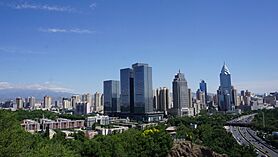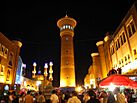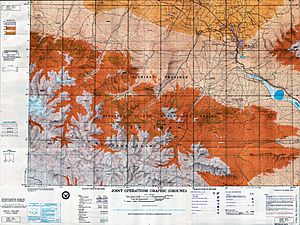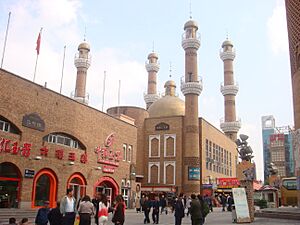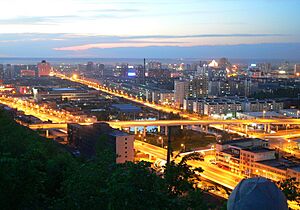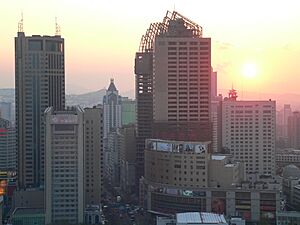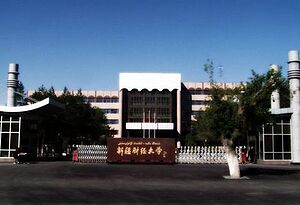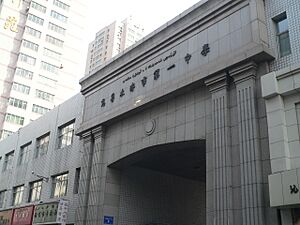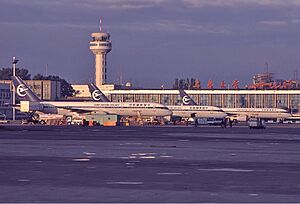Ürümqi facts for kids
Quick facts for kids
Ürümqi
Urumqi, Urumchi, Dihua, Tihwa
|
|
|---|---|
|
Prefecture-level city
|
|
|
From top to bottom, left to right: A panoramic view of Ürümqi's central business district, Ürümqi Night Market in the Grand Bazaar, Red Mountain (Hong Shan), and a view of Tian Shan from Ürümqi
|
|

Ürümqi City jurisdiction (red) in Xinjiang (orange)
|
|
| Country | China |
| Autonomous region | Xinjiang |
| County-level divisions | 8 |
| Municipal seat | Shuimogou District |
| Government | |
| • Type | Prefecture-level city |
| • Body | Ürümqi Municipal People's Congress |
| Area | |
| • Prefecture-level city | 14,577 km2 (5,628 sq mi) |
| • Urban | 583 km2 (225 sq mi) |
| Elevation | 860 m (2,820 ft) |
| Population
(2020 census)
|
|
| • Prefecture-level city | 4,054,000 |
| • Estimate
(2020)
|
4,054,000 |
| • Density | 278.11/km2 (720.30/sq mi) |
| Demographics | |
| • Major ethnic groups |
|
| GDP | |
| • Prefecture-level city | CN¥ 389.3 billion US$ 57.9 billion |
| • Per capita | CN¥ 95,511 US$ 14,200 |
| Time zone | De jure: China Standard (UTC+08:00) De facto: Both China Standard (UTC+08:00) and Ürümqi Time (UTC+06:00) |
| Postal code |
830000
|
| Area code | 991 |
| ISO 3166 code | CN-XJ-01 |
| License plate prefixes | 新A |
| Website | www.urumqi.gov.cn |
| Ürümqi | |||||||||||||||||||||
|---|---|---|---|---|---|---|---|---|---|---|---|---|---|---|---|---|---|---|---|---|---|

"Ürümqi" in Simplified Chinese (top), Traditional Chinese (middle) and Uyghur Arabic (bottom) scripts
|
|||||||||||||||||||||
| Chinese name | |||||||||||||||||||||
| Simplified Chinese | 乌鲁木齐 | ||||||||||||||||||||
| Traditional Chinese | 烏魯木齊 | ||||||||||||||||||||
| Hanyu Pinyin | Wūlǔmùqí | ||||||||||||||||||||
| Postal | Urumtsi | ||||||||||||||||||||
| Literal meaning | (from Oirat) "beautiful pasture" | ||||||||||||||||||||
|
|||||||||||||||||||||
| Abbreviation | |||||||||||||||||||||
| Simplified Chinese | 乌市 | ||||||||||||||||||||
| Traditional Chinese | 烏市 | ||||||||||||||||||||
| Hanyu Pinyin | Wūshì | ||||||||||||||||||||
|
|||||||||||||||||||||
| Former name | |||||||||||||||||||||
| Chinese | 迪化 | ||||||||||||||||||||
| Hanyu Pinyin | Díhuà | ||||||||||||||||||||
| Literal meaning | to enlighten and civilize | ||||||||||||||||||||
|
|||||||||||||||||||||
| Mongolian name | |||||||||||||||||||||
| Mongolian Cyrillic | Өрөмч | ||||||||||||||||||||
| Mongolian script | ᠥᠷᠥᠮᠴᠢ | ||||||||||||||||||||
| Uyghur name | |||||||||||||||||||||
| Uyghur | ئۈرۈمچى | ||||||||||||||||||||
|
|||||||||||||||||||||
| Kazakh name | |||||||||||||||||||||
| Kazakh |
|
||||||||||||||||||||
| Kyrgyz name | |||||||||||||||||||||
| Kyrgyz |
|
||||||||||||||||||||
Ürümqi is the capital city of the Xinjiang Uyghur Autonomous Region in Northwestern China. With over 4 million people in 2020, it is the second-largest city in China's northwest. Ürümqi is also the biggest city in Central Asia by population.
Since the 1990s, Ürümqi has grown a lot economically. Today, it is a major hub for transportation, culture, politics, and business. The city is also known for its scientific research. It is home to Xinjiang University, a top university in the region.
Contents
- What's in a Name? The Meaning of Ürümqi
- Ürümqi's Journey Through Time
- Ürümqi's Location and Environment
- Ürümqi's Cityscape and Daily Life
- How Ürümqi is Divided
- People of Ürümqi: A Diverse Community
- Ürümqi's Growing Economy
- Fun Places to Visit in Ürümqi
- Learning and Science in Ürümqi
- Getting Around Ürümqi
- Media and Entertainment in Ürümqi
- Sports in Ürümqi
- Ürümqi's Sister Cities Around the World
- Famous People from Ürümqi
- See also
What's in a Name? The Meaning of Ürümqi
The name "Ürümqi" comes from the Mongolic Oirat language. It means "beautiful pasture." This was the name of a small town started by the Dzungars. They were a Mongolic group who spoke Oirat.
How Ürümqi Got Its Name and Why It Changed
The Qing dynasty took control of Ürümqi in 1755. This happened during their fight to conquer the Dzungar Khanate. From 1763 to 1767, Qing forces made the town bigger and built walls around it.
After the expansion, the Qing dynasty renamed the city Dihua. This Chinese name meant "to enlighten and civilize." However, many people felt this name was insulting. They thought it showed ethnic bias. So, on February 1, 1954, the Chinese Communist Party changed the name back to "Ürümqi."
Ürümqi's Journey Through Time
Even though Ürümqi is close to the northern route of the Silk Road, the city we see today is quite new. The first known settlement in this area was around the 7th century CE. But for a long time, there wasn't a permanent city here. It wasn't called Ürümqi until the Dzungar Khanate in the 1600s. The current city really started to grow in the 1700s.
Early Beginnings of the City
Long ago, the area where Ürümqi now stands was home to nomadic people called the Jushi. They lived on the northern slopes of the Tianshan Mountains. These people are thought to be related to the Tocharian peoples. The Tocharians later built cities in the Tarim Basin, south of Ürümqi.
The oldest known settlement was a town called Urabo. It was about 10 kilometres (6.2 miles) from the southern part of today's Ürümqi.
The Han Chinese states to the east slowly gained control of the Tarim Basin. In 648 CE, the Tang government founded a city called Luntai. This was part of their Protectorate General to Pacify the West. Luntai was a local government center. It collected taxes from caravans traveling on the northern Silk Road.
After the Tang dynasty left the Western Regions, the area was controlled by the Uyghurs. They were part of the Khaganate and Gaochang/Qocho. There isn't much information about Ürümqi during this time. Experts believe there were no permanent settlements for most of this period. The Mongols called the wider area Beshbalik, meaning "five cities." This referred to five towns around the Ürümqi area.
The Dzungar Period and Its Influence
The Oirat-speaking Dzungar tribes formed the Dzungar Khanate. They were the last major power to control Ürümqi before the Manchus. During the Ming dynasty, there was a record of a place called Jiujiawan. It was 5 kilometres (3.1 miles) west of today's Ürümqi. This might have been the Dzungar town that was later destroyed. Mongols also used the area for herding. This location was important because it was a pass between the Bogda Shan mountains to the east and the Tian Shan mountains to the west. It connected the Dzungar Basin in the north to the Turpan Depression in the south.
Ürümqi was a small town, less important than Turpan. Turpan was an oasis and a Silk Road trade center about 200 km (120 mi) southeast. Conflicts over Dzungaria led the Khoshuuts (now called Mongols) to leave Ürümqi. They moved to Qinghai and Tibet in the 1620s and 1630s. In the 18th century, the Dzungars brought Uyghurs to the Ürümqi area. They moved them from the western Tarim region to be taranchis, or farmers, in Ürümqi.
Qing Dynasty Takes Control
In the 1700s, the Qing dynasty fought against the Dzungar Khanate. The Qing took Ürümqi in 1755. The Dzungars in the region were removed in what is known as the Dzungar genocide. One writer, Wei Yuan, described the area as "an empty plain for a thousand li, with no trace of man."
A fort was built in 1755 or 1758. The Qing then placed Manchu and Mongol soldiers (bannermen) and Han Chinese troops in Ürümqi. After 1759, the Qing government started state farms in the empty areas around Ürümqi. This land was fertile and had good water. Manchu soldiers also built a temple with red walls dedicated to Guandi. It overlooked Ürümqi from Pingding mountain. This gave Ürümqi the nickname "Red Temple."
The Manchus began building a walled city in 1763, south of the first fort. It was finished in 1767. The Qianlong Emperor named the new settlement "Dihua." This meant "to enlighten and civilize." In 1771, another city called Gongning Cheng was built nearby to the northwest. This city housed Manchu bannermen and became the government seat. The bannermen's settlement to the west was called "Mancheng" (Manchu City). Dihua to the east became a Han Chinese town, called "Hancheng" (Han City). So, early Ürümqi was a twin-city. Gongning Cheng was the government center, while Dihua became Xinjiang's business and money center.
Han Chinese people from all over China moved to Dihua. Chinese Hui Muslims from Gansu and Shaanxi also moved there. The names of their mosques often show where the Hui people in Ürümqi came from. By 1762, Chinese migrants had opened over 500 shops in the Ürümqi area. Qing scholars who visited Dihua were impressed by its culture. They said it was similar to eastern China. The writer Ji Yun compared Dihua to Beijing. Both cities had many wine shops with daily Chinese music and dance shows.
In 1870, the Battle of Ürümqi happened. It was between the Turkic Muslim forces of Yaqub Beg and the Dungan Muslim forces of Tuo Ming. With help from Xu Xuegong's Han Chinese militia, Yaqub Beg's forces won. Gongning Cheng was captured, its Qing leader was killed, and the city was burned and left empty. The Qing later got control of Ürümqi back. In 1884, the Guangxu Emperor made Xinjiang a province. Dihua became its capital.
Ürümqi in the Republican Era
After the Qing dynasty ended, Ürümqi was ruled by several warlords. These included Yang Zengxin (1911–1928), Jin Shuren (1928–1933), Sheng Shicai (1933–1942), and Zhang Zhizhong (1942–1949). Yang and Sheng were seen as good rulers.
During the Kumul Rebellion, two battles took place in Ürümqi. These were the Battle of Ürümqi (1933) and the Battle of Ürümqi (1933–34). They were fought between Ma Zhongying's forces and the provincial forces of Jin Shuren and Sheng Shicai. In the second battle, Ma was helped by the Han Chinese General Zhang Peiyuan.
Ürümqi in Modern Times
On February 1, 1954, after the People's Republic of China was founded, the city's name was officially changed back to Ürümqi. The ruling Chinese Communist Party felt that the name "Dihua" was insulting. It meant "to enlighten and civilize," which they saw as ethnically biased.
Ürümqi became the main political and economic capital of Xinjiang in 1962. This happened after protests against Chinese rule in the former capital, Yining (Ghulja). In what was called the Yi–Ta incident, 60,000 Chinese citizens left Yining and Tacheng for the Soviet Union. This led the Chinese government to move its offices and factories from Yining to Ürümqi. The government also started building a railway to connect Ürümqi to the rest of China. Because of this, Xinjiang's culture and economy shifted more towards China.
In the late 1970s, Deng Xiaoping made China's control over Xinjiang less strict. Ürümqi benefited from the growth of the oil and gas industry in Xinjiang.
New mosques were built in Ürümqi with money from the Chinese government. While the government had strict rules on religion in southern Xinjiang, the treatment of Uyghurs and their religion in Ürümqi was more relaxed.
In May 1989, there was unrest in Ürümqi. About 150 people were injured. In February 1997, bombings in Ürümqi after the Ghulja incident caused 20 deaths and many injuries.
Events in Ürümqi: July 2009 Riots
In July 2009, there were major ethnic clashes in Ürümqi. These were between Han Chinese and Uyghur groups. A reporter from the New York Times described the events. They said there were "clashes with riot police and Uyghurs rampaging through the city and killing Han civilians." Then, for at least three days, "bands of Han vigilantes roamed Urumqi, attacking and killing Uyghurs." Before the riots, young Uyghurs had marched to protest a case of unfair legal treatment. Official numbers stated that most of the 197 people killed were Han. However, Uyghurs have questioned this statement.
Ürümqi's Location and Environment
Ürümqi is the largest city in western China. It holds a record in the Guinness Book of Records as the city farthest from any sea in the world. It is about 2,500 kilometres (1,600 mi) from the nearest coastline. Ürümqi is also the closest major city to the Eurasian pole of inaccessibility. The city covers an area of 10,989 square kilometres (4,243 sq mi). Its average height above sea level is 800 metres (2,600 ft).
In 1992, experts identified a spot in the southwestern suburbs of Ürümqi as the "center point of Asia." A monument was built there in the 1990s. This site is now a popular place for tourists to visit.
Water Supply for Ürümqi
Even though deserts surround Ürümqi, it gets water from rivers. These rivers flow from the snow-covered Tian Shan mountains. The main Tian Shan range is south of the city. The Bogda Shan mountains are east of the city.
Xinjiang has 20,000 glaciers, which is almost half of all glaciers in China. Since the 1950s, Xinjiang's glaciers have shrunk by 21% to 27%. This is due to global warming. Tianshan Glacier No. 1, which feeds the Ürümqi River, is the largest glacier near a major city in China. However, it has already split into two smaller glaciers.
As Ürümqi's population and economy grow, the city needs more water than its natural supply. To help with water shortages, the Irtysh–Ürümqi Canal was built. Its main part ends at "Reservoir 500" in the city's far northeastern suburbs. A new industrial area, Ganquanbao Industrial Park, was developed nearby. It relies on this reservoir for water. From the reservoir, water is sent through canals to the Midong District.
Ürümqi's Climate and Weather
Ürümqi has a climate that is a mix of a humid continental climate and a cool semi-arid climate. This means there are big differences between summer and winter temperatures. Summers are very warm or hot, with an average July temperature of 24.2 °C (75.6 °F). Winters are very cold, with an average January temperature of −12.2 °C (10.0 °F). The average temperature for the whole year is 7.8 °C (46.0 °F).
Summers in the city get a bit more rain than winters. However, sunny weather is much more common in the warmer months. The air is also less humid in summer. The city gets about 2,643 hours of bright sunshine each year. The amount of possible sunshine ranges from 33% in December to 75% in September. The city gets about 365 millimetres (14.4 in) of rain each year. Since 1951, temperatures have ranged from a low of −41.5 °C (−42.7 °F) on February 27, 1951, to a high of 42.1 °C (107.8 °F) on August 1, 1973.
| Climate data for Ürümqi, elevation 935 m (3,068 ft), (1991–2020 normals, extremes 1951–present) | |||||||||||||
|---|---|---|---|---|---|---|---|---|---|---|---|---|---|
| Month | Jan | Feb | Mar | Apr | May | Jun | Jul | Aug | Sep | Oct | Nov | Dec | Year |
| Record high °C (°F) | 9.9 (49.8) |
13.5 (56.3) |
25.6 (78.1) |
32.5 (90.5) |
37.0 (98.6) |
40.9 (105.6) |
41.0 (105.8) |
42.1 (107.8) |
37.0 (98.6) |
30.5 (86.9) |
22.0 (71.6) |
15.6 (60.1) |
42.1 (107.8) |
| Mean daily maximum °C (°F) | −7.4 (18.7) |
−4.3 (24.3) |
5.3 (41.5) |
17.4 (63.3) |
23.4 (74.1) |
28.2 (82.8) |
30.1 (86.2) |
29.0 (84.2) |
23.1 (73.6) |
14.2 (57.6) |
3.3 (37.9) |
−4.8 (23.4) |
13.1 (55.6) |
| Daily mean °C (°F) | −12.2 (10.0) |
−8.9 (16.0) |
0.4 (32.7) |
11.5 (52.7) |
17.3 (63.1) |
22.4 (72.3) |
24.2 (75.6) |
22.9 (73.2) |
17.2 (63.0) |
8.8 (47.8) |
−0.9 (30.4) |
−9.2 (15.4) |
7.8 (46.0) |
| Mean daily minimum °C (°F) | −15.7 (3.7) |
−12.3 (9.9) |
−3.2 (26.2) |
6.6 (43.9) |
12.2 (54.0) |
17.4 (63.3) |
19.3 (66.7) |
17.9 (64.2) |
12.3 (54.1) |
4.6 (40.3) |
−4 (25) |
−12.6 (9.3) |
3.5 (38.4) |
| Record low °C (°F) | −34.1 (−29.4) |
−41.5 (−42.7) |
−33.4 (−28.1) |
−14.9 (5.2) |
−2.4 (27.7) |
4.6 (40.3) |
8.8 (47.8) |
5.0 (41.0) |
−5.0 (23.0) |
−12.4 (9.7) |
−36.6 (−33.9) |
−38.3 (−36.9) |
−41.5 (−42.7) |
| Average precipitation mm (inches) | 19.0 (0.75) |
13.6 (0.54) |
18.8 (0.74) |
38.3 (1.51) |
41.3 (1.63) |
48.8 (1.92) |
35.4 (1.39) |
30.4 (1.20) |
29.8 (1.17) |
23.8 (0.94) |
23.7 (0.93) |
25.3 (1.00) |
348.2 (13.72) |
| Average precipitation days (≥ 0.1 mm) | 8.1 | 7.3 | 5.5 | 6.7 | 6.8 | 7.2 | 8.0 | 6.3 | 4.4 | 4.8 | 6.6 | 9.6 | 81.3 |
| Average snowy days | 13.6 | 12.6 | 7.6 | 2.8 | 0.3 | 0 | 0 | 0 | 0.1 | 2.1 | 8.4 | 14.8 | 62.3 |
| Average relative humidity (%) | 77 | 77 | 68 | 45 | 41 | 41 | 43 | 42 | 43 | 54 | 72 | 78 | 57 |
| Mean monthly sunshine hours | 101.8 | 129.7 | 203.2 | 261.4 | 301.9 | 300.8 | 306.1 | 301.1 | 275.2 | 234.5 | 137.0 | 90.5 | 2,643.2 |
| Percent possible sunshine | 35 | 43 | 54 | 64 | 66 | 65 | 66 | 71 | 75 | 71 | 48 | 33 | 58 |
| Source: China Meteorological Administration | |||||||||||||
Ürümqi's Cityscape and Daily Life
Air Quality and Pollution Challenges
The Blacksmith Institute once listed Ürümqi among the "World's Worst Polluted Places" in 2007. This was due to air pollution. In 2008, the Toronto Star also named Ürümqi as one of the top ten worst places to live because of sulfur pollution.
Heavy haze is very common in winter. This often causes problems for air travel. Officials believe that the bad winter air pollution comes mainly from heavy industries. It is also caused by old coal-burning heating systems used in winter.
A report from Fudan University showed high levels of tiny particles in the air. In the winter of 2007, PM2.5 and TSP concentrations were much higher than safety standards. Sulfur dioxide from factories, mixed with local pollution and dust from outside the city, caused high sulfate levels. This is a main reason for the heavy air pollution in Ürümqi.
Understanding Sunrise Times in Ürümqi
China uses only one time zone for the whole country. Because Ürümqi is far to the west, the sun rises and sets much later there. The sun is about 2 hours and 10 minutes behind China Standard Time (CST = UTC+8).
In early January, the sun doesn't rise until 9:45 AM. It sets between 6:45 PM and 7:10 PM local time. In September and March, the sun rises around 8:00 AM and sets around 7:45 PM. However, in June, the sun rises around 6:25 AM and doesn't set until 9:45 PM.
How Ürümqi is Divided
Ürümqi has 8 main areas for its local government. These include 7 districts and 1 county.
| Map | |||||||
|---|---|---|---|---|---|---|---|

Tianshan
Saybag
Xinshi
Shuimogou
Toutunhe
Dabancheng
※ Midong
Ürümqi
County ※
|
|||||||
| Name | Simplified Chinese | Hanyu Pinyin | Uyghur (UEY) | Uyghur Latin (ULY) | Population (2010) | Area (km2) | Density (/km2) |
| City proper | |||||||
| Tianshan District | 天山区 | Tiānshān Qū | تەڭرىتاغ رايونى | Tengritagh Rayoni | 696,277 | 171 | 4071.79 |
| Saybag District | 沙依巴克区 | Shāyībākè Qū | سايباغ رايونى | Saybagh Rayoni | 664,716 | 422 | 1575.15 |
| Xinshi District | 新市区 | Xīnshì Qū | يېڭىشەھەر رايونى | Yëngisheher Rayoni | 730,307 | 143 | 5107.04 |
| Shuimogou District | 水磨沟区 | Shuǐmògōu Qū | بۇلاقتاغ رايونى | Bulaqtagh Rayoni | 390,943 | 92 | 4249.38 |
| Suburban | |||||||
| Toutunhe District | 头屯河区 | Tóutúnhé Qū | تۇدۇڭخابا رايونى | Tudungxaba Rayoni | 172,796 | 276 | 626.07 |
| Dabancheng District | 达坂城区 | Dábǎnchéng Qū | داۋانچىڭ رايونى | Dawanching Rayoni | 40,657 | 5,188 | 7.83 |
| Midong District | 米东区 | Mǐdōng Qū | مىدوڭ رايونى | Midong Rayoni | 333,676 | 3,594 | 92.84 |
| Rural | |||||||
| Ürümqi County | 乌鲁木齐县 | Wūlǔmùqí Xiàn | ئۈرۈمچى ناھىيىسى | Ürümchi Nahiyisi | 83,187 | 4,332 | 19.20 |
People of Ürümqi: A Diverse Community
Ürümqi has always been a city with many different ethnic groups. In early times, the Manchus lived in Gongning Cheng. Han Chinese lived in Dihua. Other groups like the Hui and Uyghurs lived in the areas outside the city center. Muslims settled south of the walled city of Dihua. Even though the walls are gone, Muslims are still mainly in that area.
A survey in 1787 showed that 114,348 Hui and Han people lived in the areas of Zhenxi and Ürümqi. In Ürümqi city itself, there were 39,000 people in the 1880s. By the early 1900s, there were 50,000 people. In 1908, Ürümqi had Uyghurs (then called Turkis), Chinese, Manchus, and a few Mongols. Uyghurs were thought to make up about a quarter of the population.
When the People's Republic of China was formed, a plan began to move more Han people to Xinjiang. In 1960, Ürümqi had 76,496 Uyghurs and 477,321 Han Chinese.
According to the 2000 census, Ürümqi had 2,081,834 residents. The population density was about 174.53 people per square kilometer.
In the 2010 census, the population was 3,112,559. Part of this increase was because city borders changed. For example, Miquan became part of Ürümqi in 2007.
In 2021, Ürümqi was estimated to have a population of 4.544 million people.
| Ethnicity | 2000 | 2010 | ||
|---|---|---|---|---|
| Population | % | Population | % | |
| Han Chinese | 1,567,562 | 75.30 | 2,331,654 | 74.91 |
| Uyghur | 266,342 | 12.79 | 387,878 | 12.46 |
| Hui | 167,148 | 8.03 | 280,186 | 9.00 |
| Kazakhs | 48,772 | 2.34 | 68,076 | 2.19 |
| Mongol | 7,252 | 0.35 | 10,454 | 0.34 |
| Manchu | 7,682 | 0.37 | 8,541 | 0.27 |
| Xibe | 3,674 | 0.18 | 4,820 | 0.15 |
| Russian | 2,603 | 0.13 | 3,010 | 0.10 |
| Tu | 1,613 | 0.08 | 2,869 | 0.09 |
| Kyrgyz | 1,436 | 0.07 | 2,207 | 0.07 |
| Uzbek | 1,406 | 0.07 | 1,581 | 0.05 |
| Zhuang | 878 | 0.04 | ||
| Tatar | 767 | 0.04 | ||
| Tibetan | 665 | 0.03 | ||
| Dongxiang | 621 | 0.03 | 2,333 | 0.07 |
| Miao | 620 | 0.03 | ||
| Korean | 588 | 0.03 | ||
| Other | 2,205 | 0.09 | 8,950 | 0.29 |
| Total | 2,081,834 | 3,112,559 | ||
Ürümqi's Growing Economy
Ürümqi is a major industrial hub in Xinjiang. Together with Karamay and Korla, it makes up 64.5% of Xinjiang's total industrial output. Ürümqi is also the biggest shopping center in the region. In 2008, it had ¥41.9 billion in retail sales, a 26% increase from 2007. As of 2022, the city's total economic output (GDP) was CN¥389.3 billion (about US$57.9 billion). The GDP per person was around CN¥95,511 (about US$14,200). Ürümqi has been a key focus for the China Western Development project. This is a plan by the Chinese government to develop western China.
The Urumqi Foreign Economic Relations and Trade Fair has happened every year since 1991. In 2011, it became the first China-Eurasia Expo. Its goal is to help local and international businesses. The 17th Fair had participants from China's Ministry of Commerce. It also included the China Council for Promotion of International Trade.
Xinjiang Guanghui Industry Investment Group is the largest real estate company in Xinjiang. It is also the most powerful private company there. It works in energy and cars. The China CITIC Bank Mansion, where Guanghui is based, is the tallest building in Ürümqi and Xinjiang. At 229 metres (751 feet), it is also the tallest in Northwestern China and Central Asia.
Zhongshan Road (Sun Yat-sen Road) has been one of China's ten most famous shopping streets since 2005. It has always been the center for consumer electronics in the city. It has the largest computer, mobile phone, and electronics markets in Xinjiang. These include Baihuacun, Cyber Digital Plaza, and Fountain Plaza.
As Xinjiang's economic center, Ürümqi has grown its city area since the 1990s. New business districts (CBDs) quickly appeared in all major parts of the city. While the old city areas were mainly in the south, development in the north started in the late 1980s. In 2003, the new office tower for the Ürümqi Municipal Government was finished at Nanhu Square. This marked a shift of the city center to the north.
Since Ürümqi does not have a subway, the city started building viaducts for the Outer Ring Road in 2003. This has greatly improved transportation. Youhao Road and its surrounding area are a busy center for business, shopping, and fun. Youhao Group, a local company, owns a large share of the retail market. Maison Mode Urumqi, opened in 2008, became one of the few important department stores for luxury items in the city. The Ürümqi Economic and Technological Development Zone (UETD) is in the northern Toutunhe District. It is a leading place for steel, machine making, biochemistry, and other new industries.
Fun Places to Visit in Ürümqi
- Grand Bazaar: A lively market on South Jiefang Road.
- Hong Shan (Red Mountain): This mountain is a symbol of Ürümqi. It is located in Hongshan Park.
- People's Park: Found just south of Hongshan Park.
- People's Square: A large public square in the city.
- Nanhu Square: Another important public square.
- Xinjiang Uygur Autonomous Region Museum: This museum was fully rebuilt in the early 2000s. It showcases the region's history and culture.
- Heavenly Lake Scenic Area: A popular park with beautiful alpine views. It is over two hours outside Ürümqi.
- Shuimogou Hot Springs: Located about 5 km (3.1 mi) northeast of Ürümqi.
- Xinjiang Silk Road Museum: This museum is next to the Grand Bazaar on Shengli Road. It is on the fourth and fifth floors of a large European-style building. Most exhibits have English names, and some guides speak English.
- Ürümqi City Museum: Located at South Nanhu Road 123.
- Ürümqi Tatar Mosque: Found on Jiefang Road. You need to ask for permission before visiting this mosque.
- The monument at the Geographical Center of Asian Continent: Located in Yongfeng Township, Ürümqi County.
- Ürümqi Silk Road Ski Resort: A great place for skiing, located in Ürümqi County.
- Immaculate Conception Cathedral, Ürümqi: This is the main church for the Diocese of Xinjiang.
Learning and Science in Ürümqi
Ürümqi has many places for learning. These include Xinjiang University, Xinjiang Normal University, Xinjiang Agricultural University, Xinjiang Medical University, and many more.
Universities in Ürümqi
- Xinjiang University
- Xinjiang Normal University
- Xinjiang Agricultural University
- Xinjiang Arts Institute
- Xinjiang University of Finance and Economics
- Ürümqi Vocational University
- Xinjiang Vocational and Technical Institute
- Xinjiang Medical University
High Schools in Ürümqi
- Ürümqi No.1 High School
- Bingtuan No.2 Middle School
- Bayi Senior High School of Ürümqi
- No.70 Senior High School of Ürümqi
- No.8 Senior High School of Ürümqi
- No.6 Senior High School of Ürümqi
Research Centers in Ürümqi
- Xinjiang Astronomical Observatory
- The Xingjiang Technical Institute of Physics & Chemistry.CAS
- Xingjiang Institute of Ecology and Geography
Getting Around Ürümqi
Air Travel
Ürümqi is served by the Ürümqi Diwopu International Airport. This airport is a major hub for China Southern Airlines. It is the largest airport in Xinjiang. It is also the only airport in China that has flights from Afghanistan and Tajikistan.
Train Travel
Ürümqi is Xinjiang's main train center. It has two main railway stations. These are the older Ürümqi South railway station and the Ürümqi railway station, which opened in July 2016. The Lanzhou-Xinjiang High Speed Railway stops at both stations. It runs from Ürümqi to Lanzhou railway station and has been working since late 2014.
The city also has several regular train lines. Ürümqi is the western end of the Lanzhou–Xinjiang (Lanxin) and Ürümqi–Dzungaria (Wuzhun) Railways. It is the eastern end of the Northern Xinjiang (Beijiang) and the Second Ürümqi–Jinghe railway. The Beijiang and Lanxin Lines are part of the Trans-Eurasian Continental Railway. This railway goes from Rotterdam through the Alataw Pass on the Kazakhstan border to Ürümqi, and then to Lanzhou and Lianyungang.
Road Network
- China National Highway 216
- China National Highway 312
- China National Highway 314
Many roads to the north and west usually close by early October. They stay closed until the end of winter.
Bus Rapid Transit System
The Ürümqi BRT bus service started in August 2011. It cost 930 million yuan to build. This was done to help improve city traffic. There are currently 9 routes: BRT1, BRT2, BRT3, BRT4, BRT5, BRT 6, its branch BRT 61, BRT 7, and its branch BRT 71.
Metro System
The Ürümqi Metro opened on October 25, 2018. The northern part of Line 1 was opened first. The southern part of Line 1 opened on June 28, 2019. Line 1 runs between Ürümqi Diwopu International Airport and Santunbei in downtown Ürümqi. It is 27.615 km (17.2 mi) long and has 21 stations. The entire line is underground.
The full metro system is planned to have 7 lines, totaling 211 km (131 mi). The first two lines, Line 1 and Line 2, are estimated to cost 31.24 billion yuan to build.
Media and Entertainment in Ürümqi
The Xinjiang Networking Transmission Limited runs the Ürümqi People's Broadcasting Station and the Xinjiang People Broadcasting Station. They broadcast in Mandarin, Uyghur, Kazakh, Mongolian, Russian, and Kyrgyz languages.
The Xinjiang Television Station (XJTV) is in Ürümqi. It is the main TV station for the Xinjiang Uyghur Autonomous Region. The local TV station for Ürümqi city is Ürümqi Television Station (UTV).
Sports in Ürümqi
- Xinjiang Flying Tigers: This is a basketball team that plays in the Chinese Basketball Association. They are based in Ürümqi, Xinjiang. Their main sponsor is Xinjiang Guanghui Group.
- Xinjiang Tianshan Leopard F.C.: This is a local football (soccer) team that plays in the China League One.
China started a bandy development program in Ürümqi in June 2009. This involved organizing educational days about the sport.
In 2015, an indoor arena for speed skating was opened in the city.
Ürümqi's Sister Cities Around the World
Ürümqi has special partnerships with other cities around the world. These are called twin towns or sister cities:
| City | Region | Country |
|---|---|---|
| Malaybalay | ||
| Osan | ||
| Peshawar | ||
| Dushanbe | ||
| Klang | ||
| Bishkek | Bishkek City | |
| Almaty | ||
| Chelyabinsk | ||
| Mashhad |
Almaty is a state-level city of Kazakhstan
Famous People from Ürümqi
- Dilraba Dilmurat
- Gulnazar
- Rushan Abbas
- Hassan Anvar
- Elnigar Iltebir
See also
 In Spanish: Urumqi para niños
In Spanish: Urumqi para niños


